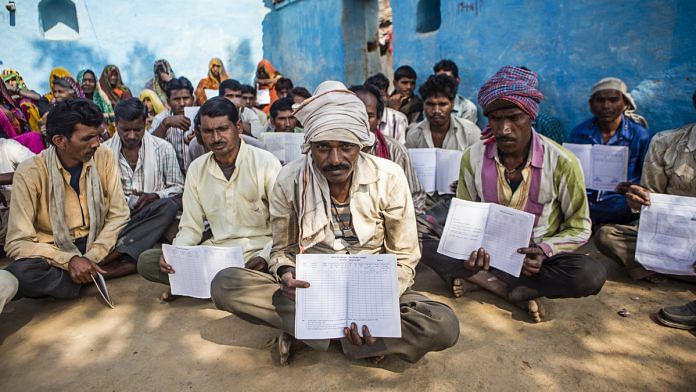The average number of days of employment so far this fiscal has been 43 while MGNREGA promises 100.
New Delhi: Just months ahead of the Lok Sabha elections, the Bharatiya Janata Party (BJP)-led government Tuesday raised the allocation to the flagship rural employment guarantee scheme to its highest ever at Rs 61,084 crore, but the number of days of employment provided on an average every year remains less than half of what the Act promises.
The Mahatma Gandhi National Rural Employment Guarantee Act (MGNREGA), introduced in February 2006 by the Congress-led United Progressive Alliance (UPA) government, promises 100 days of work to each rural household every year.
On Tuesday, the Prime Minister Narendra Modi government increased its budgetary allocation by Rs 6,084 crore as part of revised estimates to “making it the highest ever allocation”.
The move follows a letter — signed by 250 lawmakers, civil society activists and farmer leaders among others — to Modi demanding a hike in funds. The signatories claimed the scheme was facing a fund crunch with over 99 per cent of its fund already exhausted this fiscal.
Also read: Lawmakers & activists write to PM Modi raising concerns over MGNREGA fund crunch
Increasing funds, but limited employment
The scheme’s funds have been increasing over the years, but the average days of employment provided per household every year remains low, and has seen a decline in the last few years.
In 2014-15, the year the Modi government assumed office, the average days of work given to households was just 40.
This rose to around 49 days in 2015-16, but has seen a stagnation or decline since — 46 days in 2016-17, around 46 days in 2017-18 and only 43 days so far this fiscal.
The figure has consistently been less than 50 since the scheme was instituted, except in one fiscal — 2009-10, which was a drought year and also saw the general election.
In 2006-07, for instance, the scheme was implemented in 200 districts and the number of average work days per household was 43. With the scheme expanded to 615 districts in 2008-09, the figure was 48.
In the years before the last general elections — 2011-12, 2012-13 and 2013-14 — the number was at 43, 46 and 46, respectively.
The percentage of households that manage to complete the promised 100 days of work has remained significantly low, hovering below even the 15 per cent mark.
The budget for the scheme, however, has seen a massive increase from about Rs 11,000 crore in 2006-07 to Rs 40,000 crore in 2009-10 and over Rs 60,000 crore this fiscal.
Also read: MGNREGA audit: Low wage rate & delayed payments among the biggest problems
Supply-demand issue?
The Rural Development Ministry maintains that since the scheme is demand-driven, the low numbers perhaps mean less work was asked for.
Officials add that while the average number of days of work per household may be low, the need for higher funds comes because of an increase in the number of households applying for jobs under the scheme, and also, the need to spruce up the scheme’s implementation and ensure better quality of assets created.
However, the fact that households on an average have been provided much less than the promised number of days — even during distress times like after demonetisation — also points to a supply side issue and inability to generate sufficient work.
The politics of it
MGNREGA has been a political tool since its inception, given the importance of it with respect to the rural electorate.
The National Democratic Alliance (NDA) government, which started off with Modi declaring in Parliament how MGNREGA is a “living monument of the UPA’s failures”, is ending its term with the highest ever allocation to the scheme.
In the initial phase of its tenure, the BJP-led government was accused by several quarters of attempting to dilute the scheme and squeeze its funds.
However, the government gradually took to streamlining the scheme’s implementation and data shows the percentage of wages paid on time has gone up from just 27 per cent in 2014-15 to over 91 per cent this fiscal.
The Act stipulates that wages be paid within 15 days of start of work.
As the Lok Sabha elections inch closer and rural distress is seen as an important issue, the BJP hopes to go to the rural voter with claims of having furthered not just its own initiatives, but also that of the previous governments.







Modi characterised MGNREGA scheme in parliament as “khedda khodna”. But he has to go back on his position and adopt the scheme for rural development.